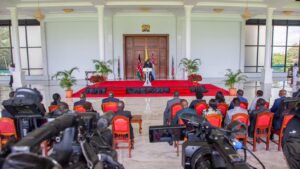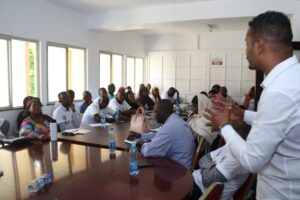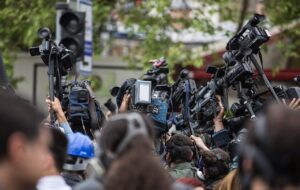The psyche of a child soldier

By Col (Rtd) Owuoth
What is the background story?
The International Criminal Court (ICC) early in February convicted Dominic On’gwen, a Ugandan Child Soldier turned Lord’s Resistance Army (LRA) commander of war and crimes against humanity. He was found guilty of 61 charges including murder, widespread rape, sexual enslavement, abducting children, torture and pillaging carried out in the early 2000s. He could serve a jail term. The convict’s lawyer’s argument in his defence was that Mr On’gwen had suffered psychological damage as a result of being abducted as a child and was himself a “victim”.
What then is a child soldier?
The United Nations Convention on the Rights of the Child defines child as ‘a human being below the age of 18 years’. A child soldier is any girl or boy below the age of 18 who is recruited or used by an armed force or armed group, in any capacity not necessarily involved in actual fighting. Children have been used as cooks, suicide bombers, human shields, messengers, spies, or for sexual purposes. The Coalition to Stop the Use of Child Soldiers estimates that there are over 300,000 children under the age of 18 serving as child soldiers with government armed forces and armed opposition groups worldwide, with over 120,000 of them located in Sub-Saharan Africa alone. Girls make up an estimated 10 to 30 per cent of the child soldiers.
How are child soldiers recruited?
The techniques used in the creation of child soldiers tend to share a few common themes. First, there is the replacement of parents with a surrogate. The child may be an orphan looking for security, or a kidnap victim whose parents have been killed in the raid. In some cases, the child is forced to commit an atrocity against his family or village that will make the child think that he would be unwelcome back at home. The child, having stripped off a parental authority figure, the commander steps into the role.
Children who are not forced to be soldiers volunteer themselves because they feel societal pressure and are under the impression that volunteering will provide a form of income, food, or security, and willingly join the group.

Why do commanders prefer child soldiers?
Commanders in the field become their foster parents and hence the child ends up being more obedient and easier to manipulate than the average adult soldier. According to a report on Sierra Leone by Human Rights Watch:
“Young boys are targeted in part because their captors consider them to be less afraid to fight; they likely do not have children or wives to consider in risking their lives. They are readily manipulated because they are vulnerable and without protection.”
Although some commanders may be enthusiastic about using child soldiers, and the weaponry today may lend itself to use by smaller soldiers, this does not mean that the children are well trained. Children make poor soldiers, as the work is physically demanding and they lack the upper-body strength of an adult. Their lack of experience and their immaturity leads to unnecessary risk-taking, and is reflected in their higher casualty rates. Children are seen as being more expendable than better-trained adult soldiers, and are used in dangerous assaults, clearing mines, and as spies.
How are child soldiers deployed in conflict situations?
Although the use of children in warfare is not in itself new, the scale of their involvement varies in so many ways. Teenage boys have always participated in battlefield non-combat tasks, such as runners and drummers, but never in the numbers seen today. Several thousands of children served in resistance movements during the 1939-45 War, and in many of the colonial liberation wars of the 1950s and 1960s. The modern jihadist movements commonly use children as suicide bombers. Using the child in modern conflicts is also the norm partly due to the fact that modern assault rifles are lighter and easier to use than their predecessors.
For example, the ubiquitous AK-47 weighs only 9.5 pounds, is easy to use and maintain, and is widely available, with between 35 and 50 million in existence. The M-16 rifle weighs 6.4 pounds, with about 8 million in existence. Children can handle these weapons with little difficulty. The light weight and ease of use of modern small-arms has thus facilitated the recruitment of children in modern war.
Is there any justification of using a child solder?
Beyond the obvious distaste with using children in such dangerous and violent work, could it not be argued that they equally share in the fate of their nation? When faced with annihilation doesn’t a nation have the right to turn to whatever resources it has to aid in the fight? The child has no mental balance to make a decision on matters of life and death.
How does conflict affect the child soldier?
Four main ways spring to mind:
- The use of a child as a combatant creates a more unpredictable and unstable soldier than an adult while exacting a more acute impact psychological cost on the child.
- Child soldiers have poorer training than their adult counterparts, are more disposed to taking risks, and are preferred by some commanders because they can be forced to do things that adults would not.
- Child soldiers are trained to overcome a reluctance to kill through operant conditioning. Children brutalized in this way suffer from severe emotional problems, and these problems remain into adulthood.
- Another aspect of the use of child soldiers is the long-term risks associated with Post-Traumatic Stress Disorder (PTSD). The stress of losing their families, being uprooted from their homes, and being physically, psychologically and sexually abused will leave the children traumatized. As the nations were, this kind of activity occurs are almost invariably poor, it is unlikely that mental health care will be available to treat them for PTSD.
How does the law of armed conflict plead for the child?
The Laws of Armed Conflict make a special case for children. They do so because the psychological damage inflicted upon children by participation in combat is contrary to the long-term aim of the Laws of armed conflict: To reduce suffering of the victims and to establish conditions favourable to a viable and lasting peace. Children that have been brutalized by combat grow up to be dangerous adults invariably only resorting to violence to solve their problems.
What are the final thoughts?
The use of children in combat is a growing phenomenon that has negative consequences at all levels. Individually, the child suffers in both psychological and moral development. Society suffers because of the cost of bearing a generation that knows only violence. Progress is being made diplomatically to outlaw the use of children in combat. The nations that use child soldiers cannot afford to rehabilitate them, but leaving them untreated places many developing countries at risk. The cost of treating these children will still be considerably less than replacing the infrastructure lost to wars caused by a generation of children that were taught only violence.







Africa is the leading region in child abuse including labor, sexual abuse and many more. We need the help of other nations to be our brother’s keeper. Thanks for highlighting this issue.